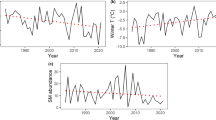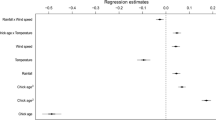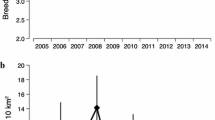Abstract
The reproductive success of predators depends on abiotic environmental conditions, food abundance and population density, and food abundance, density and their interactions may respond to changes in climatic conditions. Timing of reproduction by five of the eight numerically most common prey of the sparrowhawk Accipiter nisus advanced significantly since 1971, during a period of temperature increase. There was no evidence that mean laying date or any other reproductive parameter of sparrowhawks changed consistently during the study period 1977–1997. Laying date advanced and percentage of unsuccessful female sparrowhawks decreased with beech mast in the current year, an index of food abundance for avian prey. Mean laying date of sparrowhawks was advanced in warmer springs, and although mean clutch size was not larger in warm than in cold springs, mean brood size of successful pairs and breeding success increased in such springs, showing that sparrowhawks enjoyed a fitness gain when reproducing early. The timing of sparrowhawk reproduction with respect to the peak in abundance of fledgling prey increased, from a good match between mean timing of fledging by prey and maximum demand for food by the predator in 1977, to reproduction occurring later than the peak in fledging prey availability in 1997. The size of the breeding population of sparrowhawks was not predicted by mean spring temperature, the size of the breeding population the previous year or beech mast crop. The size of the post-breeding population was predicted by size of the breeding and post-breeding population the previous year and by the proportion of unsuccessful females the current year. These findings imply that sparrowhawks did not respond to change in climate, although climate changed the timing of reproduction by the main prey species.





Similar content being viewed by others
References
Bejer B, Rudemo M (1985) Fluctuations of tits (Paridae) in Denmark and their relations to winter food and climate. Ornis Scand 16:29–37
Böhning-Gaese K, Lemoine N (2004) Importance of climate change for the ranges, communities and conservation of birds. In: Møller AP, Fiedler W, Berthold P (eds) Effects of climatic change on birds. Elsevier, Amsterdam, pp 211–236
Both C, Visser ME (2001) Adjustment of climate change is constrained by arrival date in a long-distance migrant bird. Nature 411:296–298
Both C, Artemyev AV, Blaauw B, Cowie RJ, Dekhuijzen AJ, Eeva T, Enemar A, Gustafsson L, Ivankina EV, Järvinen A, Metcalfe NB, Nyholm NEI, Potti J, Ravussin PA, Sanz JJ, Silverin B, Slater FM, Sokolov LV, Török J, Winkel W, Wright J, Zang H, Visser ME (2004) Large-scale geographical variation confirms that climate change causes birds to lay earlier. Proc R Soc Lond B 271:1657–1662
Burnham KP, Anderson DR (1998) Model selection and inference. Springer, Berlin Heidelberg New York
Chatfield C (1999) The analysis of time-series: an introduction. 5th edn. Chapman and Hall, Boca Raton
Crick HQP, Sparks TH (1999) Climate change related to egg-laying trends. Nature 399:423
Crick HQP, Gibbons DW, Magrath RD (1993) Seasonal changes in clutch size in British birds. J Anim Ecol 62:263–273
Dunn P (2004) Breeding dates and reproductive performance. In: Møller AP, Fiedler W, Berthold P (eds) Effects of climatic change on birds. Elsevier, Amsterdam, pp 69–87
Dunn PO, Winkler DW (1999) Climate change has affected the breeding date of tree swallows throughout North America. Proc R Soc Lond B 266:2487–2490
Green R (1979) Sampling design and statistical methods for environmental biologists. Wiley, New York
Houghton JT, Ding Y, Griggs DJ, Noguer M, van der Linden PJ, Dai X, Maskell K, Johnson CA (eds) (2001) Climate change 2001: The scientific basis. Cambridge University Press, Cambridge
Jacobsen EM (1994) Danske vinterfugles forekomst 1975/76–1992/93 i relation til skovtræernes frøsætning [Danish, with English summary]. Dansk Orn Foren Tidsskr 88:79–84
Järvinen A (1989) Patterns and causes of long-term variation in reproductive traits of the Pied Flycatcher Ficedula hypoleuca in Finnish Lapland. Ornis Fenn 66:24–31
Jenni L (1987) Mass concentrations of bramblings Fringilla montifringilla in Europe 1900–1983—their dependence upon beech mast and the effect of snow cover. Ornis Scand 18:84–94
JMP (2000) JMP. SAS Institute, Cary
Källander H (1981) The effects of provision of food in winter on a population of the great tit Parus major and the blue tit Parus caeruleus. Ornis Scand 12:244–248
Kareiva PM, Kingsolver JG, Huey RB (1993) Biotic interactions and global change. Sinauer, Sunderland
Merilä J, Sheldon BC (2001) Avian quantitative genetics. Curr Ornithol 16:179–225
Møller AP (2002) North Atlantic Oscillation (NAO) effects of climate on the relative importance of first and second clutches in a migratory passerine birds. J Anim Ecol 71:201–210
Møller AP, Erritzøe J (2002) Climate, body condition and spleen size in birds. Oecologia 137:621–626
Møller AP, Merilä J (2004) Analysis and interpretation of long-term studies investigating responses to climate change. In: Møller AP, Fiedler W, Berthold P (eds) Effects of climatic change on birds. Elsevier, Amsterdam, pp 111–130
Moss D (1979) Growth of nestling sparrowhawks (Accipiter nisus). J Zool Lond 187:297–314
Mouritsen KN, Poulin R (2002) Parasitism, climate oscillations and the structure of natural communities. Oikos 97:462–468
Newton I (1986) The sparrowhawk. Poyser, Berkhamstead
Newton I (1988) A key factor analysis of a sparrowhawk population. Oecologia 76:588–596
Newton I, Marquiss M (1981a) Moult in the sparrowhawk. Ardea 70:163–172
Newton I, Marquiss M (1981b) Effect of additional food on laying dates and clutch sizes of sparrowhawks. Ornis Scand 12:224–229
Newton I, Marquiss M (1984) Seasonal trend in the breeding performance of sparrowhawk. J Anim Ecol 53:809–829
Newton I, Marquiss M (1986) Population regulation in sparrowhawks. J Anim Ecol 55:463–480
Nielsen JT (2004a) A population study of sparrowhawks Accipiter nisus in Vendsyssel, Denmark, 1977–1997 [Danish, with English summary]. Dansk Orn Foren Tidsskr 98:147–162
Nielsen JT (2004b) Prey selection of sparrowhawks in Vendsyssel, Denmark [Danish, with English summary]. Dansk Orn Foren Tidsskr 98:164–173
Opdam P, Müskens G (1976) Use of shed feathers in population studies of Accipiter hawks (Aves, Accipitriformes, Accipitridae). Beaufortia 24:55–62
Parmesan C, Yohe G (2003) A globally coherent fingerprint of climate change impacts across natural systems. Nature 421:37–42
Perdeck AC, Visser ME, Van Balen JH (2000) Great Tit Parus major survival, and the beech-crop cycle. Ardea 88:99–108
Perrins CM (1979) British tits. Collins, London
Przybylo R, Sheldon BC, Merilä J (2000) Climate effects on breeding and morphology: evidence for phenotypic plasticity. J Anim Ecol 69:395–403
Pulido F, Berthold P (2004) Microevolutionary response to climatic change. In: Møller AP, Fiedler W, Berthold P (eds) Effects of climatic change on birds. Elsevier, Amsterdam, pp 151–184
Roff DA (1997) Evolutionary genetics. Chapman and Hall, New York
Root TL, Price JL, Hall KR, Schneider SH, Rosenzweig C, Pounds AJ (2003) Fingerprints of global warming on wild animals and plants. Nature 421:57–60
Rueness EK, Stenseth NC, O’Donoghue M, Boutin S, Ellegren H, Jakobsen KS (2003) Ecological and genetic spatial structuring in the Canadian lynx. Nature 425:69–72
Sæther B-E, Engen S, Møller AP, Matthysen E, Adriaensen F, Fiedler W, Leivits A, Lambrechts MM, Visser M, Anker-Nilssen T, Both C, Dhondt A, McCleery RH, McMeeking J, Potti J, Røstad OW, Thomson D (2003) Climate variation and regional gradients in the population dynamics of two hole nesting passerines. Proc R Soc Lond B 270:2397–2404
Sæther B-E, Sutherland W, Engen S (2004) Climate influences on avian population dynamics. In: Møller AP, Fiedler W, Berthold P (eds) Effects of climatic change on birds. Elsevier, Amsterdam, pp 185–209
Sanz JJ (2002) Climate change and breeding parameters of great and blue tits throughout the western Palaearctic. Global Change Biol 8:409–422
Sanz JJ (2003) Large-scale effect of climate change on breeding parameters of pied flycatchers in Western Europe. Ecography 26:45–50
Sanz JJ, Potti J, Moreno J, Merino S, Frias O (2003) Climate change and fitness components of a migratory bird breeding in the Mediterranean region. Global Change Biol 9:461–472
Sheldon BC, Kruuk LE, Merilä J (2003) Natural selection and inheritance of breeding time and clutch size in the collared flycatcher. Evolution 57:406–420
Sokal RR, Rohlf FJ (1995) Biometry, 3rd edn. Freeman, New York
Spiller DA, Schoener TW (1994) Effects of top and intermediate predators in a terrestrial food-web. Ecology 75:182–196
Tryjanowski P, Sparks TH, Kuczynski L, Kuzniak S (2004) Should avian egg size increase as a result of global warming? A case study using the red-backed shrike (Lanius collurio). J Orn 145:264–268
Verhulst S (1992) Effects of density, beech crop and winter feeding on survival of juvenile great tits—an analysis of Kluyver’s removal experiment. Ardea 80:285–292
Visser ME, Holleman LJM (2001) Warmer springs disrupt the synchrony of oak and winter moth phenology. Proc R Soc Lond B 268:289–294
Visser ME, van Noordwijk AJ, Tinbergen JM, Lessells CM (1998) Warmer springs lead to mistimed reproduction in great tits (Parus major). Proc R Soc Lond B 265:1867–1870
Visser ME, Adriaensen F, van Balen JH, Blondel J, Dhondt AA, van Dongen S, du Feu C, Ivankina EV, Kerimov AB, de Laet J, Matthysen E, McCleery R, Orell M, Thomson DL (2003) Variable responses to large-scale climate change in European Parus populations. Proc R Soc Lond B 270:367–372
Visser ME, Both C, Lambrechts MM (2004) Avian timing of reproduction, food availability and climate change. In: Møller AP, Fiedler W, Berthold P (eds) Effects of climatic change on birds. Elsevier, Amsterdam, pp 89–110
Walther G-R, Post E, Convey P, Menzel A, Parmesan C, Beebee TJC, Fromentin J-M, Høgh-Guldberg O, Bairlein F (2002) Ecological responses to recent climate change. Nature 416:389–395
Winkel W, Hudde H (1997) Long-term trends in reproductive traits of tits (Parus major, P. caeruleus) and pied flycatchers Ficedula hypoleuca. J Avian Biol 28:187–190
Winkler DW, Dunn PO, McCulloch CE (2002) Predicting the effects of climate change on avian life-history traits. Proc Natl Acad Sci USA 99:13595–13599
Yom-Tov Y (2001) Global warming and body mass decline in Israeli passerine birds. Proc R Soc Lond B 268:947–952
Yom-Tov Y, Benjamini Y, Kark S (2002) Global warming, Bergmann’s rule and body mass - are they related? The chukar partridge (Alectoris chukar) case. J Zool, Lond 257:449–455
Acknowledgements
We would like to thank all landowners that provided access to their properties. H. Grunnet and J.K. Jensen helped collect some of the material. K. Klarborg kindly gave access to data on tits. The Danish Meteorological Institute provided information on weather. J.T. Lausen provided beech mast indices. We thank B.-E. Sæther and M.E. Visser for constructive comments.
Author information
Authors and Affiliations
Corresponding author
Additional information
Communicated by Markku Orell.
Rights and permissions
About this article
Cite this article
Nielsen, J.T., Møller, A.P. Effects of food abundance, density and climate change on reproduction in the sparrowhawk Accipiter nisus . Oecologia 149, 505–518 (2006). https://doi.org/10.1007/s00442-006-0451-y
Received:
Accepted:
Published:
Issue Date:
DOI: https://doi.org/10.1007/s00442-006-0451-y




